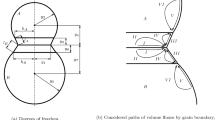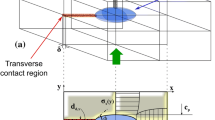A new approach is proposed to model the sintering of inhomogeneous macroscopic powder bodies. Each macroscopic element has a corresponding representative cell defined at the mesoscopic level of powder particles. Numerical modeling is carried out both at the level of representative cells and macroscopic level. The new approach does not use macroscopic constitutive equations in analytical form but rather derive them by homogenization over the representative cells. Thus, the number of internal parameters in sintering models can be increased and the effect of other parameters such as pore size distribution and anisotropy on sintering kinetics can be considered. Free sintering of ceramic matrix composites with coarse inert inclusions is modeled as an example. It is shown that the results of modeling and experiment agree if shear-induced dilatation of ceramic matrix powder during sintering is assumed.
Similar content being viewed by others
References
V. V. Skorokhod, Rheological Theory of Sintering [in Russian], Naukova Dumka, Kiev (1972).
E. A. Olevsky, “Theory of sintering from discrete to continuum,” Mat. Sci. Eng. R., 23, No. 2, 41–100 (1998).
P. Z. Cai, G. L. Messing, and D. J. Green, “Determination of the mechanical response of sintering compacts by cyclic loading dilatometry,” J. Am. Ceram. Soc., 80, 445–452 (1997).
A. L. Maksimenko, “Direct multiscale modeling of cold pressing of metal powders,” Powder Metall. Met. Ceram., 48, No. 3–4, 145–151 (2009).
Ya. E. Geguzin, Physics of Sintering [in Russian], Nauka, Moscow (1984).
H. J. Frost and M. F. Ashby, Deformation-Mechanism Maps, Pergamon Press, Oxford (1982).
I. M. Lifshits and V. B. Shikin, “Diffusion viscous flow of porous bodies,” Fiz. Trerd. Tela, No. 6, 1735–1743 (1964).
A. Needleman and J. R. Rice, “Plastic creep flow effects in the diffusive cavitation of grain boundaries,” Acta Met., 28, 1315–1332 (1980).
J. Pan, and A. C. F. Cocks, “A numerical technique for the analysis of coupled surface and grain-boundary diffusion,” Acta Met. Mat., 43, No. 4, 1395–1406 (1995).
J. Svoboda and H. Riedel, “Pore-boundary interactions and evolution equations for the porosity and evolution equations for the porosity and grain size during sintering,” Acta Met. Mat., 40, No. 11, 2829–2840 (1992).
G. W. Scherer, “Sintering with rigid inclusions,” J. Am. Ceram. Soc., 70, No. 10, 719–725 (1987).
R. K. Bordia and G. W. Scherer, “On constrained sintering. Part III. Rigid inclusions,” Acta Met., 36, No. 9, 2411–2416 (1988).
R. K. Bordia and R. Raj, “Sintering of TiO2–Al2O3 composites: a model experimental investigation,” J. Am. Ceram. Soc., 34, No. 7, 302–310 (1988).
G. W. Scherer and A. Jagota, “Viscosities and sintering rates of a two-dimensional granular composite,” J. Am. Ceram. Soc., 76, No. 12, 3123–3135 (1993).
C. R. Blanchard and K. S. Chen, “Evidence of grain-boundary sliding induced cavitation in ceramics under compression,” J. Am. Ceram. Soc., 76, No. 7, 1651–1660 (1993).
K. S. Chen, R. A. Page, and J. Lankford, “Cavity nucleation at grain-boundary ledges,” Acta Met., 34, No. 12, 2361–2370 (1986).
M.-Y. Chu, L. C. de Jonghe, and M. N. Rahaman, “Effect of temperature on the densification/ creep viscosity during sintering,” Acta Met., 37, No. 5, 1415–1420 (1989).
M. W. Weiser and L. C. de Jonghe, “Inclusion size and sintering of composite powders,” J. Am. Ceram. Soc., 71, No. 3, 125–128 (1988).
Author information
Authors and Affiliations
Corresponding author
Additional information
Translated from Poroshkovaya Metallurgiya, Vol. 49, No. 1–2 (471), pp. 32–41, 2010.
Rights and permissions
About this article
Cite this article
Maksimenko, A.L. Direct multiscale modeling of diffusion sintering of ceramic composites. Powder Metall Met Ceram 49, 24–30 (2010). https://doi.org/10.1007/s11106-010-9197-5
Received:
Published:
Issue Date:
DOI: https://doi.org/10.1007/s11106-010-9197-5




